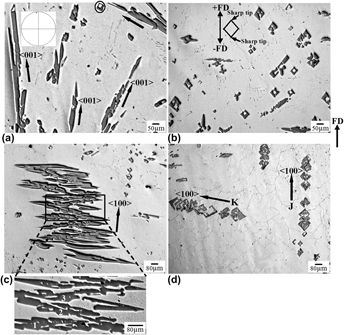Crossref Citations
This article has been cited by the following publications. This list is generated based on data provided by
Crossref.
Li, Lei
Zhu, Qingfeng
Zhang, Hui
Zuo, Yubo
Ban, Chunyan
He, Lizi
Liu, Haitao
and
Cui, Jianzhong
2014.
Morphological and crystallographic characterization of solidified Al–3Ti–1B master alloy under a high magnetic field.
Materials Characterization,
Vol. 95,
Issue. ,
p.
1.
Kang, Huijun
Wang, Tongmin
Li, Xinzhong
Su, Yanqing
Guo, Jingjie
and
Fu, Hengzhi
2014.
Faceted–nonfaceted growth transition and 3-D morphological evolution of primary Al6Mn microcrystals in directionally solidified Al–3 at.% Mn alloy.
Journal of Materials Research,
Vol. 29,
Issue. 11,
p.
1256.
Du, Dafan
Lu, Zhenyuan
Gagnoud, Annie
Fautrelle, Yves
Ren, Zhongming
Lu, Xionggang
Moreau, Rene
and
Li, Xi
2015.
Effect of a high axial magnetic field on the structure of directionally solidified Al–Si alloys.
Journal of Materials Research,
Vol. 30,
Issue. 8,
p.
1043.
Li, Lei
Xu, Bo
Tong, Wei-Ping
Zhang, Hui
Ban, Chun-Yan
He, Li-Zi
Zhao, Zhi-Hao
Zuo, Yu-Bo
Zhu, Qing-Feng
and
Cui, Jian-Zhong
2015.
Directional Growth of Tin Crystals Controlled by Combined Solute Concentration Gradient Field and Static Magnetic Field.
Acta Metallurgica Sinica (English Letters),
Vol. 28,
Issue. 6,
p.
725.
Wang, Jiang
Fautrelle, Yves
Nguyen-Thi, Henri
Reinhart, Guillaume
Liao, Hanlin
Li, Xi
Zhong, Yunbo
and
Ren, Zhongming
2016.
Thermoelectric Magnetohydrodynamic Flows and Their Induced Change of Solid–Liquid Interface Shape in Static Magnetic Field-Assisted Directional Solidification.
Metallurgical and Materials Transactions A,
Vol. 47,
Issue. 3,
p.
1169.
Li, Lei
Ban, Chunyan
Shi, Xuchen
Zhang, Haitao
Zuo, Yubo
Zhu, Qingfeng
Wang, Xiangjie
Zhang, Hui
Cui, Jianzhong
and
Nagaumi, Hiromi
2017.
Effects of a high magnetic field on the primary zinc-rich crystals in hypoeutectic Zn-Sn alloy.
Journal of Crystal Growth,
Vol. 463,
Issue. ,
p.
59.
Li, Lei
Ban, Chunyan
Shi, Xuchen
Zhang, Haitao
Zuo, Yubo
Zhu, Qingfeng
Wang, Xiangjie
Cui, Jianzhong
and
Nagaumi, Hiromi
2017.
Influence of a high magnetic field on the solidification structures of ternary Al–Fe–Zr alloy.
Journal of Materials Research,
Vol. 32,
Issue. 11,
p.
2035.
Liu, Huan
Xuan, Weidong
Xie, Xinliang
Li, Chuanjun
Wang, Jiang
Yu, Jianbo
Li, Xi
Zhong, Yunbo
and
Ren, Zhongming
2017.
Columnar-to-Equiaxed Transition and Equiaxed Grain Alignment in Directionally Solidified Ni3Al Alloy Under an Axial Magnetic Field.
Metallurgical and Materials Transactions A,
Vol. 48,
Issue. 9,
p.
4193.
Li, Lei
Ban, Chunyan
Zhang, Ruixue
Zhang, Haitao
Cai, Minghui
Zuo, Yubo
Zhu, Qingfeng
Wang, Xiangjie
and
Cui, Jianzhong
2017.
Morphological and Crystallographic Characterization of Primary Zinc-Rich Crystals in a Ternary Sn-Zn-Bi Alloy under a High Magnetic Field.
Crystals,
Vol. 7,
Issue. 7,
p.
204.
Biswas, Prosanta
Patra, Surajit
and
Mondal, Manas Kumar
2018.
Effects of Mn addition on microstructure and hardness of Al-12.6Si alloy.
IOP Conference Series: Materials Science and Engineering,
Vol. 338,
Issue. ,
p.
012043.
Lu, Zhenyuan
Ren, Zhongming
Fautrelle, Yves
and
Li, Xi
2018.
Modification of the Primary and Peritectic Phases in Directionally Solidified Cu-20 wt.% Sn Alloy by Magnetic Field.
ISIJ International,
Vol. 58,
Issue. 3,
p.
505.
Milyutin, V.A.
and
Gervasyeva, I.V.
2019.
Thermally activated transformations in alloys with different type of magnetic ordering under high magnetic field.
Journal of Magnetism and Magnetic Materials,
Vol. 492,
Issue. ,
p.
165654.
Jia, Qingbo
Rometsch, Paul
Cao, Sheng
Zhang, Kai
and
Wu, Xinhua
2019.
Towards a high strength aluminium alloy development methodology for selective laser melting.
Materials & Design,
Vol. 174,
Issue. ,
p.
107775.
Cai, Qi
Zhai, Cong
Luo, Qun
Zhang, Tong-Yi
and
Li, Qian
2019.
Effects of magnetic field on the microstructure and mechanical property of Mg-Al-Gd alloys.
Materials Characterization,
Vol. 154,
Issue. ,
p.
233.
Biswas, Prosanta
Patra, Surajit
Roy, Himadri
Tiwary, Chandra Sekhar
Paliwal, Manas
and
Mondal, Manas Kumar
2021.
Effect of Mn Addition on the Mechanical Properties of Al–12.6Si Alloy: Role of Al15(MnFe)3Si2 Intermetallic and Microstructure Modification.
Metals and Materials International,
Vol. 27,
Issue. 6,
p.
1713.
Biryukov, Vladimir
Princ, Anton
Gradov, Oleg
and
Bazlova, Tatiana
2022.
Technological Advancements in Construction.
Vol. 180,
Issue. ,
p.
521.
Xiang, K
Huang, S
and
Mi, J
2023.
Characterisations of the Al-Mn intermetallic phases formed under pulse magnetic fields solidification.
IOP Conference Series: Materials Science and Engineering,
Vol. 1274,
Issue. 1,
p.
012004.
Xiang, Kang
Qin, Ling
Zhao, Yuliang
Huang, Shi
Du, Wenjia
Boller, Elodie
Rack, Alexander
Li, Mengnie
and
Mi, Jiawei
2024.
Operando study of the dynamic evolution of multiple Fe-rich intermetallics of an Al recycled alloy in solidification by synchrotron X-ray and machine learning.
Acta Materialia,
Vol. 279,
Issue. ,
p.
120267.
Biswas, Prosanta
Raj, Akash
Neelakantan, Suresh
and
Mondal, Manas Kumar
2025.
Wear Micromechanics, Mechanisms, and Wear Map of Al–12.6Si–0.25Fe–x Mn Alloy: The Role of Al15(Mn,Fe)3Si2 Intermetallic and Microstructure Modification.
Journal of Tribology,
Vol. 147,
Issue. 3,
